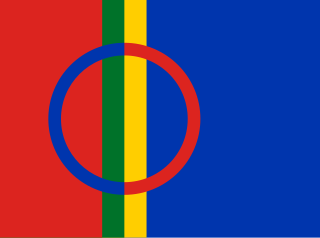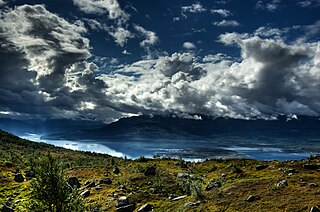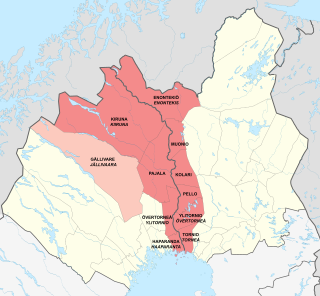
The demography of Sweden is monitored by the Statistiska centralbyrån. Sweden's population was 10,555,448, making it the 15th-most populous country in Europe after Czech Republic, the 10th-most populous member state of the European Union, and the 87th-most populous country in the world. The total fertility rate was rated at 1.66 in 2020, which is far below the replacement rate of 2.1.

The Sámi are the traditionally Sámi-speaking Indigenous peoples inhabiting the region of Sápmi, which today encompasses large northern parts of Norway, Sweden, Finland, and of the Kola Peninsula in Russia. The region of Sápmi was formerly known as Lapland, and the Sámi have historically been known in English as Lapps or Laplanders, but these terms are regarded as offensive by the Sámi, who prefer their own endonym, e.g. Northern Sámi Sápmi. Their traditional languages are the Sámi languages, which are classified as a branch of the Uralic language family.

Östra Göinge Municipality is a municipality in Scania County in southern Sweden. Its seat is located in Broby.

Norrbotten County is the northernmost county or län of Sweden. It is also the largest county by land area, almost a quarter of Sweden's total area. It shares borders with Västerbotten County to the southwest, the Gulf of Bothnia to the southeast, the counties of Nordland and Troms in Norway to the northwest, and Lapland Province in Finland to the northeast.

Skåneland or Skånelandene (Danish) is a region on the southern Scandinavian peninsula. It includes the Swedish provinces of Blekinge, Halland, and Scania. The Danish island of Bornholm is traditionally also included. Skåneland has no official recognition or function and the term is not in common usage. Equivalent terms in English and Latin are "the Scanian Provinces" and "Terrae Scaniae" respectively. The term is mostly used in historical contexts and not in daily speech. In Danish, Skånelandene is used more often. The terms have no political implications as the region is not a political entity but a cultural region, without officially established administrative borders.

Sweden Finns are a Finnish-speaking national minority in Sweden.

The Treaty of Roskilde was negotiated at Høje Taastrup Church and signed (NS) during the Second Northern War between Frederick III of Denmark–Norway and Karl X Gustav of Sweden in the Danish city of Roskilde. After a devastating defeat, Denmark–Norway was forced to give up a third of its territory to save the rest, the ceded lands comprising Blekinge, Bornholm, Bohuslän (Båhuslen), Scania (Skåne) and Trøndelag, as well as her claims to Halland.
For hundreds of years up until the 18th century, the history of the province of Scania was marked by the struggle between the two Scandinavian kingdoms of Denmark and Sweden over the hegemony in the Baltic area.

Meänkieli, or Tornedalian is a Finnic language or a group of distinct Finnish dialects spoken in the northernmost part of Sweden along the valley of the Torne River. Meänkieli is recognized in Sweden as country's five minority languages and is treated as a distinct language from Finnish, however its status as an independent Finnic language is sometimes disputed due to its mutual intelligibility with Finnish. According to the National Association of Swedish Tornedalians, 70,000 individuals are able to understand Meänkieli, at least to some level.

Meänmaa, or sometimes Torne Valley or Torne River Valley lies at the border of Sweden and Finland. It is named after the Torne River flowing through the valley and into the Gulf of Bothnia. Geographically the townships and municipalities that make up the area are Haparanda, Övertorneå, Pajala and Kiruna in Sweden, and Tornio, Ylitornio, Pello, Kolari, Muonio and Enontekiö in Finland. Culturally the highland Swedish municipality Gällivare is sometimes also considered part of Meänmaa due to the large share of Meänkieli-speaking population in it. Torne Valley should not be confused with Torne Valley Sub-region.

Tornedalians are an ethnic minority native to the Torne Valley (Meänmaa) region in northern Sweden and Finland. Tornedalians are since year 2000 a recognized national minority in Sweden. Tornedalians generally divide themselves into three distinct groups: Tornedalians, Kvens, and Lantalaiset.
In 1999, the Minority Language Committee of Sweden formally declared five official minority languages: Finnish, Sámi languages, Romani, Yiddish, and Meänkieli.

The Scanian War was a part of the Northern Wars involving the union of Denmark–Norway, Brandenburg and Sweden. It was fought from 1675 to 1679 mainly on Scanian soil, in the former Danish–Norwegian provinces along the border with Sweden, and in Northern Germany. While the latter battles are regarded as a theater of the Scanian war in English, Danish, Norwegian and Swedish historiography, they are seen as a separate war in German historiography, called the Swedish-Brandenburgian War.

Swedish is the official language of Sweden and is spoken by the vast majority of the 10.23 million inhabitants of the country. It is a North Germanic language and quite similar to its sister Scandinavian languages, Danish and Norwegian, with which it maintains partial mutual intelligibility and forms a dialect continuum. A number of regional Swedish dialects are spoken across the country. In total, more than 200 languages are estimated to be spoken across the country, including regional languages, indigenous Sámi languages, and immigrant languages.

Scania, also known by its native name of Skåne, is the southernmost of the historical provinces of Sweden. Located in the south tip of the geographical region of Götaland, the province is roughly conterminous with Skåne County, created in 1997. Like the other historical provinces of Sweden, Scania still features in colloquial speech and in cultural references, and can therefore not be regarded as an archaic concept. Within Scania there are 33 municipalities that are autonomous within the Skåne Regional Council. Scania's largest city, Malmö, is the third-largest city in Sweden, as well as the fifth-largest in Scandinavia.

The relations between Denmark and Sweden span a long history of interaction. The inhabitants of each speak related North Germanic languages, which have a degree of mutual intelligibility. Both countries formed part of the Kalmar Union between 1397 and 1523, but there exists an inherited cultural competition between Sweden and Denmark. From 1448 to 1790 the two kingdoms went to war against each other at nearly every opportunity; in more than one case a new king tried to prove his worth by waging war on the other country for little or no political reason. Several Dano-Swedish wars took place between 1521 and 1814.

Joachim Gersdorff was a Danish politician, from 1650 to 1660 Steward of the Danish Realm. It was Gersdorff who negotiated the Treaty of Roskilde on Denmark's part during the Second Northern War, a war he had himself been in favour of entering. Through this treaty, which was concluded in Roskilde on 8 March 1658 (NS), the eastern Danish provinces of Scania, Halland, Blekinge and Bornholm were ceded to Sweden.
Birgitte "Brita" Scheel (1638–1699), was a Danish noblewoman who married a Danish nobleman who became Swedish with the annexation of Denmark's eastern provinces. For that reason, Birgitte belongs both to Danish and Swedish history, and her family lives on in the now Swedish province of Scania (Skåne).
Jens Mikkelsen Ehrenborg was a Danish soldier and public servant who later became a Swedish nobleman. He was born in 1621 in Fredericia in southern Jutland in Denmark. His name was also spelled Jöns Michelsson, Jens Michelsen or Jöns Michaelson. Upon his ennoblement in 1687, he was given the surname Ehrenborg.

The Swedification of Scania refers to the process in which the former Danish province of Scania was culturally and linguistically integrated and made into a part of the Swedish Empire, in the context of 17th century Swedish expansion within Scandinavia. Today, more than 300 years later, Scania is the southernmost part of Sweden.

















